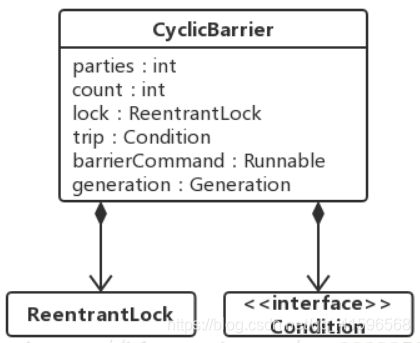线程同步器原理剖析
文章目录
文章创作参考来源于 Java并发-----第10章 Java并发包中线程同步器原理剖析
1. CountDownLatch原理剖析
(1). 介绍
日常开发中经常碰到等待其他线程运行结束的情况,之前学习的方法中,可以使用Thread.join()方法实现,但是有很多局限性,且不够灵活
使用CountDownLatch可以更好的实现这个功能.
// new一个CountDownLatch对象,传入参数为要监控的线程数.
CountDownLatch countDownLatch = new CountDownLatch(2);
// 主线程(或者灵活的选择使用场景)中使用,会挂起当前线程,知道CountDownLatch对象的计数器为0
countDownLatch.await();
// 在子线程中使用,CountDownLatch的计数器会减一,当计数器为0时,
countDownLatch.countDown();
它的优点有:
- 更灵活:可以再子线程的任意处位置让程序计数器自减.
- 更实用:在线程池开发中,通常不会直接操作线程对象传入的都是Runnable或者Callable对象,没有join()方法可以调用.而CountDownLatch的使用不受影响.
(2). 实现原理
1). 结构

内部使用AQS实现,计数器的值被赋给了AQS的状态变量state.
2). void await()方法
当CountDownLatch对象调用await()方法后,当前线程或被阻塞,知道下面的情况才会返回:
- 所有线程都调用了CountDownLatch对象的countDown()方法,也就是说计数器的值为0时.
- 其他线程调用了当前线程的interrupt()方法中断了当前线程,该方法会抛出InterruptedException异常后返回.
public void await() throws InterruptedException {
sync.acquireSharedInterruptibly(1);
}
// 响应中断的共享锁
public final void acquireSharedInterruptibly(int arg) throws InterruptedException {
if (Thread.interrupted())
throw new InterruptedException();
// state若不为0,进入AQS队列等待
if (tryAcquireShared(arg) < 0)
doAcquireSharedInterruptibly(arg);
}
protected int tryAcquireShared(int arg) {
return (getState() == 0) ? 1 : -1;
}
3). boolean await(long timeout, TimeUnit unit)方法
与上一个类似,但是当设置的timeout时间到了,会因为超时返回false.
public boolean await(long timeout, TimeUnit unit) throws InterruptedException {
return sync.tryAcquireSharedNanos(1, unit.toNanos(timeout));
}
4). void countDown()方法
public void countDown() {
sync.releaseShared(1);
}
public final boolean releaseShared(int arg) {
// 设置state--
if (tryReleaseShared(arg)) {
// 上一步操作成功,则说明state已经为0,释放资源(AQS队列首元素啥的)
doReleaseShared();
return true;
}
return false;
}
protected boolean tryReleaseShared(int releases) {
for (;;) {
// 获取state,如果为0,则不需要在释放资源了,返回false
// 防止计数器为零后,其他线程仍然调用,使计数器为负数
// 否则state--(自旋+CAS操作)
int c = getState();
if (c == 0)
return false;
int nextc = c-1;
if (compareAndSetState(c, nextc))
return nextc == 0;
}
}
5). long getCount()方法
public long getCount() {
return sync.getCount();
}
int getCount() {
return getState();
}
2. 回环屏障CyclicBarrier原理探究
(1). 介绍
CountDownLatch的计数器是一次性的,也就是说等计数器的值为0时,在调用await和countDown方法都会立刻返回,起不到线程同步的效果了.
为了满足计数器可以重置的需要,JDK提供了CyclicBarrier类,功能并不局限于CountDownLatch的功能.

从字面意思理解,CyclicBarrier是回环屏障的意思,它可以让一组线程全部达到一个状态后在全部同时执行.当所有等待线程执行完毕并重置CyclicBarrier的状态后,它可以被重用.
之所以被叫做屏障是因为调用await方法后会被阻塞,这个阻塞点被称为屏障点,等所有线程都调用了await方法后,线程们就会冲破屏障,继续向下运行.
public class Demo {
// 创建一个CyclicBarrier实例,添加一个当所有线程冲破屏障后都会执行的方法
private static CyclicBarrier cyclicBarrier = new CyclicBarrier(2, new Runnable() {
@Override
public void run() {
System.out.println("ok ok");
}
});
public static void main(String[] args) {
ExecutorService executorService = Executors.newFixedThreadPool(2);
// 线程池中添加两个任务
executorService.submit(new Runnable() {
@Override
public void run() {
try {
System.out.println("A1");
// 执行完await方法后会等待其他线程
// 当所有线程都执行之后,会执行传入cyclicBarrier对象的方法
cyclicBarrier.await();
System.out.println("A2");
cyclicBarrier.await();
} catch (Exception e) {
e.printStackTrace();
}
}
});
executorService.submit(new Runnable() {
@Override
public void run() {
try {
System.out.println("B1");
cyclicBarrier.await();
System.out.println("B2");
cyclicBarrier.await();
} catch (Exception e) {
e.printStackTrace();
}
}
});
executorService.shutdown();
}
}
/////////////////////////////执行结果///////////////////////////////////
A1
B1
ok ok
B2
A2
ok ok
(2). 实现原理
1). 结构

CyclicBarrier基于独占锁实现,本质底层还是AQS的.
parties用来记录线程个数,表示当多少线程调用了await()方法后,所有线程才会冲破屏障.是构造器中第一个参数.
count记录当前await()方法的调用数,一开始等于parties.这里使用两个值存储的意图在于实现复用.
变量generation内部有一个变量broken,用来记录当前屏障是否被打破,并没有被声明为volatile,其操作都在锁内部使用,不需要.
2). int await()方法
挂起调用的线程直到下面的情况才会返回:
- parties个线程都调用了await()方法,也就是线程都到达了屏障点
- 其他线程中断了当前线程,会抛出InterruptedException
- 与当前屏障点关联的Generation对象的broken标志被设置为true,会抛出BrokenBarrierException
public int await() throws InterruptedException, BrokenBarrierException {
try {
return dowait(false, 0L);
} catch (TimeoutException toe) {
throw new Error(toe); // cannot happen
}
}
2). int await(long timeout, TimeUnit unit)方法
此方法除了上面的三种情况外,超时也会返回,不报异常,返回false
public int await(long timeout, TimeUnit unit)
throws InterruptedException,BrokenBarrierException,TimeoutException {
return dowait(true, unit.toNanos(timeout));
}
3). int dowait(boolean timed, long nanos)方法
private int dowait(boolean timed, long nanos)
throws InterruptedException, BrokenBarrierException,TimeoutException {
// 加锁
final ReentrantLock lock = this.lock;
lock.lock();
try {
final Generation g = generation;
// 如果屏障已经被破坏,抛异常
if (g.broken)
throw new BrokenBarrierException();
// 响应中断
if (Thread.interrupted()) {
breakBarrier();
throw new InterruptedException();
}
// 计数器减一
int index = --count;
if (index == 0) { // 进行完本次计数后,全部线程都到达了屏障点,即将进行固定的回调
boolean ranAction = false;
try {
final Runnable command = barrierCommand;
if (command != null)
command.run();
// 运行成功(无异常)标记
ranAction = true;
// 重置CyclicBarrier,换代,释放所有的锁
nextGeneration();
return 0;
} finally {
// 如果未执行成功,设置为屏障被冲破
if (!ranAction)
breakBarrier();
}
}
// 自旋
for (;;) {
try {
// 是否有超时的限制,没有则直接挂起
if (!timed)
trip.await();
// 时间合理,则挂起相应时间
else if (nanos > 0L)
nanos = trip.awaitNanos(nanos);
} catch (InterruptedException ie) {
// 被中断时判断是否换代,没换代的话是否还没被破坏
if (g == generation && ! g.broken) {
breakBarrier();
throw ie;
} else {
// 被破坏说明此时是经历自旋到达这里的
Thread.currentThread().interrupt();
}
}
// 当有任何一个线程中断了,就会调用breakBarrier方法
// 就会唤醒其他的线程,其他线程醒来后,也要抛出异常
if (g.broken)
throw new BrokenBarrierException();
// 如果已经换代。那么直接返回index
if (g != generation)
return index;
// 超时之后打破屏障并且抛异常
if (timed && nanos <= 0L) {
breakBarrier();
throw new TimeoutException();
}
}
} finally {
lock.unlock();
}
}
private void nextGeneration() {
// signal completion of last generation
trip.signalAll();
// set up next generation
count = parties;
generation = new Generation();
}
private void breakBarrier() {
generation.broken = true;
count = parties;
trip.signalAll();
}
3. 信号量Semaphore原理探究
(1). 介绍
不同于前两个的地方是,内部计数器是递增的,而且不需要知道需要同步的现成的个数,而是需要在主线程等待的地方传入线程数.
(2). 实现原理
1). 结构
内部有两个AQS的实现,分别对应公平和非公平策略

2). void acquire()方法
调用该方法的目的是获取一个信号量资源,如果当前信号量个数大于0,则计数减一,直接返回.
如果当前信号量等于0,将当前线程放入AQS阻塞队列.
该方法响应中断,会抛出异常.
public void acquire() throws InterruptedException {
sync.acquireSharedInterruptibly(1);
}
public final void acquireSharedInterruptibly(int arg) throws InterruptedException {
// 如果线程已经是中断状态,抛出异常
if (Thread.interrupted())
throw new InterruptedException();
// 尝试获取资源(多个等待线程之间要阻塞)
if (tryAcquireShared(arg) < 0)
//
doAcquireSharedInterruptibly(arg);
}
//非公平策略
protected int tryAcquireShared(int acquires) {
return nonfairTryAcquireShared(acquires);
}
final int nonfairTryAcquireShared(int acquires) {
for (;;) {
// 获取当前信号量,计算剩余值
int available = getState();
int remaining = available - acquires;
// 如果剩余值小于0,返回剩余值(这一步返回正数说明当前的信号量满足要求,不用被阻塞)
// 否则进行CAS竞争,成功的线程返回修改后的值
if (remaining < 0 || compareAndSetState(available, remaining))
return remaining;
}
}
//公平策略
protected int tryAcquireShared(int acquires) {
for (;;) {
// 公平性的关键,查看该节点的前继节点是否也在获取资源,如果是,本线程放弃
if (hasQueuedPredecessors())
return -1;
int available = getState();
int remaining = available - acquires;
if (remaining < 0 || compareAndSetState(available, remaining))
return remaining;
}
}
3). void acquire(int permits)方法
传入当前需要的信号量
public void acquire(int permits) throws InterruptedException {
if (permits < 0)
throw new IllegalArgumentException();
sync.acquireSharedInterruptibly(permits);
}
4). void acquireUninterruptibly()方法
该方法挂起时不响应中断
public void acquireUninterruptibly() {
sync.acquireShared(1);
}
5). void acquireUninterruptibly(int permits)方法
public void acquireUninterruptibly(int permits) {
if (permits < 0) throw new IllegalArgumentException();
sync.acquireShared(permits);
}
6). void release()方法
public void release() {
sync.releaseShared(1);
}
public final boolean releaseShared(int arg) {
// 这里自旋+CAS,一定会成功
if (tryReleaseShared(arg)) {
// 成功则调用park方法唤醒挂起的等待线程
// 等待线程会进行信号量的判断,如果足够就解锁,不足继续挂起
doReleaseShared();
return true;
}
return false;
}
protected final boolean tryReleaseShared(int releases) {
for (;;) {
int current = getState();
int next = current + releases;
if (next < current) // overflow
throw new Error("Maximum permit count exceeded");
if (compareAndSetState(current, next))
return true;
}
}
7). void release(int permits)方法
public void release(int permits) {
if (permits < 0)
throw new IllegalArgumentException();
sync.releaseShared(permits);
}
